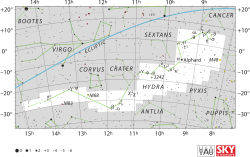うみへび座パイ星
表示
| うみへび座π星[1] Pi Hydrae | ||
|---|---|---|
| 星座 | うみへび座 | |
| 見かけの等級 (mv) | 3.28[1] | |
| 分類 | 橙色巨星[1] | |
| 位置 元期:J2000.0[1] | ||
| 赤経 (RA, α) | 14h 06m 22.29749s[1] | |
| 赤緯 (Dec, δ) | −26° 40′ 56.5024″[1] | |
| 赤方偏移 | 0.000091[1] | |
| 視線速度 (Rv) | 27.20 km/s[1] | |
| 固有運動 (μ) | 赤経: 43.70 ミリ秒/年[1] 赤緯: -141.18 ミリ秒/年[1] | |
| 年周視差 (π) | 32.30 ± 0.16ミリ秒[1] (誤差0.5%) | |
| 距離 | 101 ± 0.5 光年[注 1] (31 ± 0.2 パーセク[注 1]) | |
| 絶対等級 (MV) | 0.8[注 2] | |
π星の位置
| ||
| 物理的性質 | ||
| 半径 | 12 - 13 R☉[2] | |
| 質量 | 1.76[3] - 2.45[4] M☉ | |
| 表面重力 | 2.65 (log g)[5] | |
| 自転速度 | 2.25 km/s[5] | |
| スペクトル分類 | K2-IIIFe-0.5[1] | |
| 表面温度 | 4,670 K[5] | |
| 色指数 (B-V) | 1.091[5] | |
| 金属量[Fe/H] | 0.04[6] | |
| 他のカタログでの名称 | ||
| うみへび座49番星[1] CD-26 10095[1] CPD-26 5170[1] FK5 519[1] GJ 538.1[1] GSC 06738-01381[1] HD 123123[1] HIP 68895[1] HR 5287[1] SAO 182244[1] TYC 6738-1381-1[1] 2MASS J14062229-2640565[1] |
||
| ■Template (■ノート ■解説) ■Project | ||
うみへび座π星(英語: Pi Hydrae)は、うみへび座に位置している3等級の恒星で[7]、肉眼で観望する事も出来る。年周視差による測定から基づくと、この恒星は地球から101光年離れている[8]。
特徴
[編集]自転速度は2.25km/sと、とても低速であるとされている[5]。表面温度は4,670Kで、橙色に輝く巨星である[9]。
周辺減光を補正した後に測定された角直径は3.76 ± 0.04ミリ秒で[10]、これを基に計算すると、半径は太陽の12-13倍となる[2]。質量は、太陽の2.45倍である[4]。
脚注
[編集]注釈
[編集]出典
[編集]- ^ a b c d e f g h i j k l m n o p q r s t u v w x “SIMBAD Astronomical Database”. Result for pi Hra. CDS. 2018年1月22日閲覧。
- ^ a b Lang, Kenneth R. (2006), Astrophysical formulae, Astronomy and astrophysics library, 1 (3rd ed.), Birkhäuser, ISBN 3-540-29692-1. The radius (R*) is given by:
- ^ Hekker, S.; Reffert, S.; Quirrenbach, A.; Mitchell, D. S.; Fischer, D. A.; Marcy, G. W.; Butler, R. P. (August 2006), “Precise radial velocities of giant stars. I. Stable stars”, Astronomy and Astrophysics 454 (3): 943–949, arXiv:astro-ph/0604502, Bibcode: 2006A&A...454..943H, doi:10.1051/0004-6361:20064946
- ^ a b Edvardsson, B. (January 1988), “Spectroscopic surface gravities and chemical compositions for 8 nearby single sub-giants”, Astronomy and Astrophysics 190 (1–2): 148–166, Bibcode: 1988A&A...190..148E
- ^ a b c d e Hekker, S.; Meléndez, J. (December 2007), “Precise radial velocities of giant stars. III. Spectroscopic stellar parameters”, Astronomy and Astrophysics 475 (3): 1003–1009, arXiv:0709.1145, Bibcode: 2007A&A...475.1003H, doi:10.1051/0004-6361:20078233
- ^ Luck, R. Earle (February 1991), “Chemical abundances for cyanogen-weak giants”, Astrophysical Journal Supplement Series 75: 579–610, Bibcode: 1991ApJS...75..579L, doi:10.1086/191542
- ^ Wielen, R.; Schwan, H.; Dettbarn, C.; Lenhardt, H.; Jahreiß, H.; Jährling, R. (1999), “Sixth Catalogue of Fundamental Stars (FK6). Part I. Basic fundamental stars with direct solutions”, Veröff. Astron. Rechen-Inst. Heidelb (Astronomisches Rechen-Institut Heidelberg) 35 (35), Bibcode: 1999VeARI..35....1W
- ^ van Leeuwen, F. (2007), “Validation of the new Hipparcos reduction”, Astronomy and Astrophysics 474 (2): 653–664, arXiv:0708.1752, Bibcode: 2007A&A...474..653V, doi:10.1051/0004-6361:20078357
- ^ “The Colour of Stars”, Australia Telescope, Outreach and Education (Commonwealth Scientific and Industrial Research Organisation), (December 21, 2004), オリジナルの2012年5月24日時点におけるアーカイブ。 2016年10月12日閲覧。
- ^ Richichi, A.; Percheron, I.; Khristoforova, M. (February 2005), “CHARM2: An updated Catalog of High Angular Resolution Measurements”, Astronomy and Astrophysics 431 (2): 773–777, Bibcode: 2005A&A...431..773R, doi:10.1051/0004-6361:20042039


